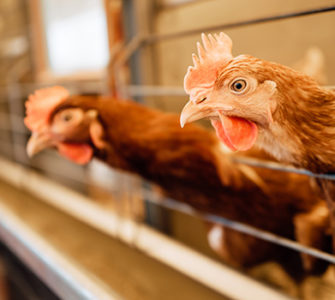Essential adjustments that improve IB vaccine efficacy in broilers
A few essential adjustments in the way infectious bronchitis vaccines are handled and administered at the hatchery can improve vaccine efficacy, Brian Jordan, PhD, assistant professor, University of Georgia, told Poultry Health Today.
“Frozen vaccines that come out of liquid nitrogen have to have a little bit more care,” Jordan cautioned.
When the vaccines are put into warm water for quick thawing so they can be mixed and taken to the production floor promptly, “…a lot of hatcheries actually make mistakes. That water bath does not need to be too warm,” he said.
If the water bath is 98° F (37° C), the vaccines can overheat and become damaged. Instead, Jordan recommended a water bath that’s about 75° F (24° C). The vaccine will only take about 1 to 2 minutes to thaw at that temperature, he said.
“I’ve done a lot of sampling in the field working with producers, and their vaccine takes just aren’t what they should be after vaccination. And, you know, one vaccine may be okay and one’s not, and when you go back and look at it, it’s always the one that’s the frozen product that seems to be more variable. And it’s because of that thawing step,” Jordan said.
Don’t overchill diluent
Freeze-dried vaccines require less attention since they are simply taken from the refrigerator, reconstituted then used, but with freeze-dried or frozen vaccines, there’s another pitfall to avoid, and that occurs when mixing the vaccine with chilled water or diluent.
“Now, one of the questions that I often get asked is, ‘How cold do we need it to be?’ because when I say ‘chilled,’ immediately people think of frozen or really cold refrigerated water. And that’s not actually the case,” he continued.
The vaccine diluent should be about 50° F to 55° F (10° C to 13° C) to start. “By the time you use it in an hour or an hour and a half, it’s not going to get any warmer than 65° F, 70° F (18° C to 21° C). And that 70° F mark is really what you’re concerned with when you’re talking about your respiratory, your bronchitis, your Newcastle vaccines. Because once you get above 70° F, you do start losing titer…” Jordan said.
He also advised against mixing more vaccine doses than can be applied in about an hour’s time.
More volume is better
Respiratory vaccines used to be applied in a 7 ml volume, “just because that’s the way we’d always done it.” Based on research, “we’re actually losing a lot of our vaccine between the nozzle and the chicks because those droplets are so small they’re influenced by air movement and just aren’t heavy enough to really settle down.” A volume of 14 ml or even 21 ml for application is better, Jordan said.
“Volume is critical, but droplet size is even more critical,” he said, “because the bigger the droplet, the heavier it will be and the faster it will actually reach the chicks” because it’s less influenced by air movement.
“If you can do 21 ml, then that’s great. A lot of producers don’t want to go that much volume, because that’s a lot of water to put on the chicks, so 14 seems to be a good medium that people have settled on,” he said. Another way to increase droplet size is by using a larger nozzle. A 300 micron to 400 micron droplet size is a good range to be in, Jordan said.
Drying chicks post-vaccination
Asked if chicks getting too wet and then chilled is a concern with increased volume, Jordan said, “There’s no difference in chick body temperatures once they dry, which takes about 10 minutes. It’s really not that big of an issue, but you do see better vaccine takes because we’re getting those larger droplets that can get into that respiratory mucosa a lot better than those really small ones do.”
It’s a misconception, he said, that the goal of spraying on a respiratory vaccine is to get chicks to inhale the vaccine. “What we are actually doing with spray vaccination is trying to recreate eyedrop vaccination on a mass scale. Eyedrop is our gold standard for respiratory vaccination. And larger droplets actually are better for trying to recreate an eyedrop vaccination on that larger scale.”
Check spray-cabinet pressure
Jordan also advised checking spray-cabinet pressure. If it’s too great, virus particles in the vaccine are destroyed whether it’s a respiratory or coccidia vaccine being applied. When the plastic syringes commonly used pull back and the barrel is refilled with more vaccine in preparation to spray the next basket of chicks, there’s turbulence and a shearing force inside the syringe. “If you just sit there and watch the syringes on the cabinet, you’ll see those bubbles that are created and that shearing force.”
“It’s not the pressure setting on the outside. It’s actually an internal adjustment on how fast the barrel of that syringe is refilled, and all you need it to do is refill fast enough to be ready for your next chick basket. It doesn’t have to be as fast as possible,” he said.
After vaccination, care must be taken to avoid stacking chicks too close together because they can get overheated. If they’re stacked too far apart, they can get too cold because fans are blowing on them, they’ll huddle, won’t dry as quickly and the vaccine is not fully utilized.
Storage tips
Other advice from Jordan included proper maintenance of the liquid nitrogen tank where vaccines are stored. The tank should be checked for seal leaks and to make sure there’s enough liquid nitrogen to maintain necessary cold temperatures. Don’t assume tanks have enough liquid nitrogen or are cold enough just because vapor is coming out when you open the tanks, he warned.
“You need to constantly monitor your tank” by using a dipstick, ruler or anything else that can provide an idea of how much nitrogen is in the tank, he said.
Freeze-dried vaccines kept in the refrigerator are typically fairly stable, but the refrigerators he sees in hatcheries are colder by the refrigerator component mechanism. “Sometimes that’s in the bottom, sometimes it’s in the back. If it’s a refrigerator/freezer combination, it’ll be colder by the freezer. And you want to store your respiratory vaccines in the colder area,” Jordan said. Conversely, coccidia vaccines are more sensitive to cold and should be stored in the warmer part of the refrigerator, he noted.
Posted on December 5, 2021

















